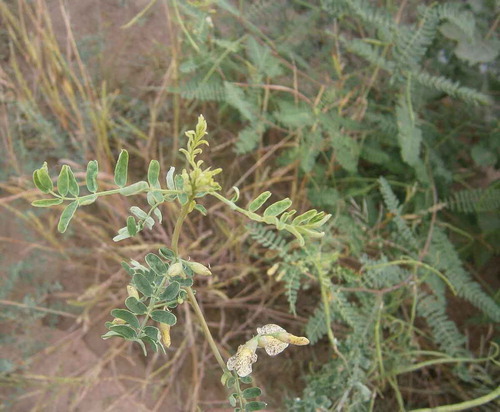Figures & data
Fig. 1 (Colour online) Leaf curling and yellowing symptoms on a Sesbania bispinosa plant in a cotton field, while asymptomatic S. bispinosa plants can be seen in the background.

Table 1. Open reading frames in the Pedilanthus leaf curl virus (PeLCV) and Tobacco leaf curl betasatellite (TbLCB) isolated from Sesbania bispinosa.
Fig. 2 (Colour online) Neighbour joining phylogenetic dendrograms and pairwise percentage identities of Pedilanthus leaf curl virus (PeLCV) and Tobacco leaf curl betasatellite (TbLCB) isolates from Sesbania bispinosa with other similar sequences retrieved from NCBI nucleotide database. The phylogenetic trees are based on pair-wise alignment, done using CLUSTAL W program of MEGA 6 and percentage identities were calculated using sequence demarcation tool (SDT) MUSCLE. The nomenclature of each sequence in the tree is: Name of virus- [Country:Location:Host:Year of sample collection]-Accession number. Both trees are supported by 1000 bootstrap value, represented with each root. a, The phylogenetic tree of whole genome of virus indicates that PeLCV isolated from S. bispinosa is closely related to PeLCV isolated from soybean from Pakistan (green). Overall PeLCV shows similarity with [RaLCuV (red)] and Papaya leaf curl virus [PaLCuV (blue)] isolates from various hosts in Pakistan and India. Tomato mottle virus (ToMoV) is used as an outgroup. b, The graphical representation of pairwise identities based on SDT MUSCLE alignment and the colour table on the right describes the percentage identity that each colour represents. c, The phylogenetic tree of betasatellites shows that TbLCB isolated from S. bispinosa is closely related to the three isolates of TbLCB, one from Pedilanthus and two from tobacco (green). Overall the sequences of TbLCB show association with Radish leaf curl betasatellite (RaLCB) isolates from various hosts in Pakistan and India (red). Cotton leaf curl Multan alphasatellite (CLCuMuA) is used as an outgroup.
![Fig. 2 (Colour online) Neighbour joining phylogenetic dendrograms and pairwise percentage identities of Pedilanthus leaf curl virus (PeLCV) and Tobacco leaf curl betasatellite (TbLCB) isolates from Sesbania bispinosa with other similar sequences retrieved from NCBI nucleotide database. The phylogenetic trees are based on pair-wise alignment, done using CLUSTAL W program of MEGA 6 and percentage identities were calculated using sequence demarcation tool (SDT) MUSCLE. The nomenclature of each sequence in the tree is: Name of virus- [Country:Location:Host:Year of sample collection]-Accession number. Both trees are supported by 1000 bootstrap value, represented with each root. a, The phylogenetic tree of whole genome of virus indicates that PeLCV isolated from S. bispinosa is closely related to PeLCV isolated from soybean from Pakistan (green). Overall PeLCV shows similarity with [RaLCuV (red)] and Papaya leaf curl virus [PaLCuV (blue)] isolates from various hosts in Pakistan and India. Tomato mottle virus (ToMoV) is used as an outgroup. b, The graphical representation of pairwise identities based on SDT MUSCLE alignment and the colour table on the right describes the percentage identity that each colour represents. c, The phylogenetic tree of betasatellites shows that TbLCB isolated from S. bispinosa is closely related to the three isolates of TbLCB, one from Pedilanthus and two from tobacco (green). Overall the sequences of TbLCB show association with Radish leaf curl betasatellite (RaLCB) isolates from various hosts in Pakistan and India (red). Cotton leaf curl Multan alphasatellite (CLCuMuA) is used as an outgroup.](/cms/asset/21131376-2b29-4a77-8e02-785271bd9d83/tcjp_a_1128980_f0002_oc.jpg)
